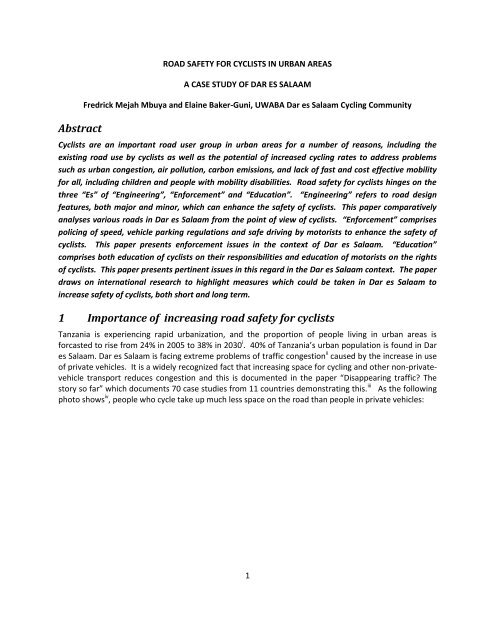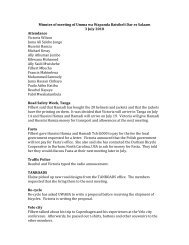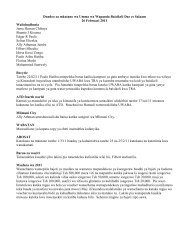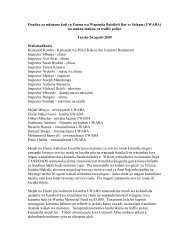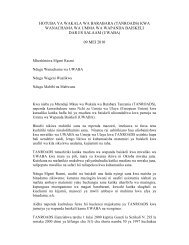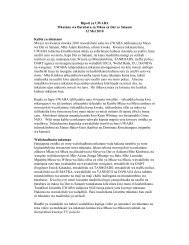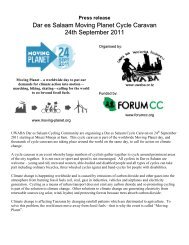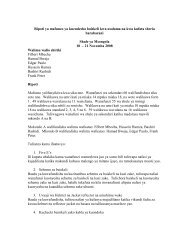Abstract 1 Importance of increasing road safety for ... - Uwaba.or.tz
Abstract 1 Importance of increasing road safety for ... - Uwaba.or.tz
Abstract 1 Importance of increasing road safety for ... - Uwaba.or.tz
Create successful ePaper yourself
Turn your PDF publications into a flip-book with our unique Google optimized e-Paper software.
<strong>Abstract</strong>ROAD SAFETY FOR CYCLISTS IN URBAN AREASA CASE STUDY OF DAR ES SALAAMFredrick Mejah Mbuya and Elaine Baker-Guni, UWABA Dar es Salaam Cycling CommunityCyclists are an imp<strong>or</strong>tant <strong>road</strong> user group in urban areas <strong>f<strong>or</strong></strong> a number <strong>of</strong> reasons, including theexisting <strong>road</strong> use by cyclists as well as the potential <strong>of</strong> increased cycling rates to address problemssuch as urban congestion, air pollution, carbon emissions, and lack <strong>of</strong> fast and cost effective mobility<strong>f<strong>or</strong></strong> all, including children and people with mobility disabilities. Road <strong>safety</strong> <strong>f<strong>or</strong></strong> cyclists hinges on thethree “Es” <strong>of</strong> “Engineering”, “En<strong>f<strong>or</strong></strong>cement” and “Education”. “Engineering” refers to <strong>road</strong> designfeatures, both maj<strong>or</strong> and min<strong>or</strong>, which can enhance the <strong>safety</strong> <strong>of</strong> cyclists. This paper comparativelyanalyses various <strong>road</strong>s in Dar es Salaam from the point <strong>of</strong> view <strong>of</strong> cyclists. “En<strong>f<strong>or</strong></strong>cement” comprisespolicing <strong>of</strong> speed, vehicle parking regulations and safe driving by mot<strong>or</strong>ists to enhance the <strong>safety</strong> <strong>of</strong>cyclists. This paper presents en<strong>f<strong>or</strong></strong>cement issues in the context <strong>of</strong> Dar es Salaam. “Education”comprises both education <strong>of</strong> cyclists on their responsibilities and education <strong>of</strong> mot<strong>or</strong>ists on the rights<strong>of</strong> cyclists. This paper presents pertinent issues in this regard in the Dar es Salaam context. The paperdraws on international research to highlight measures which could be taken in Dar es Salaam toincrease <strong>safety</strong> <strong>of</strong> cyclists, both sh<strong>or</strong>t and long term.1 <strong>Imp<strong>or</strong>tance</strong> <strong>of</strong> <strong>increasing</strong> <strong>road</strong> <strong>safety</strong> <strong>f<strong>or</strong></strong> cyclistsTanzania is experiencing rapid urbanization, and the prop<strong>or</strong>tion <strong>of</strong> people living in urban areas is<strong>f<strong>or</strong></strong>casted to rise from 24% in 2005 to 38% in 2030 i . 40% <strong>of</strong> Tanzania’s urban population is found in Dares Salaam. Dar es Salaam is facing extreme problems <strong>of</strong> traffic congestion ii caused by the increase in use<strong>of</strong> private vehicles. It is a widely recognized fact that <strong>increasing</strong> space <strong>f<strong>or</strong></strong> cycling and other non-privatevehicletransp<strong>or</strong>t reduces congestion and this is documented in the paper “Disappearing traffic? Thest<strong>or</strong>y so far” which documents 70 case studies from 11 countries demonstrating this. iii As the followingphoto shows iv , people who cycle take up much less space on the <strong>road</strong> than people in private vehicles:1
Cycling <strong>of</strong>fers numerous mobility benefits to the user relative to public transp<strong>or</strong>t and walking,particularly over distances <strong>of</strong> 2-10km. It is a private, do<strong>or</strong>-to-do<strong>or</strong> means <strong>of</strong> transp<strong>or</strong>t which does notinvolve walking to a bus stop, waiting <strong>f<strong>or</strong></strong> a bus <strong>or</strong> the risk <strong>of</strong> the bus being full <strong>or</strong> overcrowded. Cyclingis much quicker than walking. Cycling also has health benefits; The WHO Charter on Transp<strong>or</strong>t,Environment and Health (London, June 1999) aims to promote cycling and walking and suggests thathalf an hour’s daily exercise significantly reduces the risk <strong>of</strong> heart disease, diabetes, obesity, and highblood pressure. In addition, the cost <strong>of</strong> maintaining a bicycle <strong>f<strong>or</strong></strong> a year is approximately 2.5% <strong>of</strong> the cost<strong>of</strong> maintaining a private vehicle <strong>f<strong>or</strong></strong> a year, and also compares favourably to the cost <strong>of</strong> public transp<strong>or</strong>t,given that individual residents <strong>of</strong> Dar es Salaam typically spend Tsh 200,000 to Tsh 400,000 per year onbus fares. A case study from South Africa shows low-income earners spending 25% <strong>of</strong> income on publictransp<strong>or</strong>t to and from w<strong>or</strong>k; with bicycle purchase, after initial purchase cost, the household cost <strong>of</strong>transp<strong>or</strong>t was reduced to 5% <strong>of</strong> income after three months. vCycling is also an environmentally friendly means <strong>of</strong> transp<strong>or</strong>t as it does not have any emissions.Tanzania is committed to improving urban air quality through increased provision <strong>f<strong>or</strong></strong> non-mot<strong>or</strong>isedtransp<strong>or</strong>t, as stated in the “Eastern Africa Regional Framew<strong>or</strong>k Agreement on Air Pollution” adopted at aMinisterial conference on air quality in Nairobi in 2008, which undertakes to:2
“Encourage the use <strong>of</strong> non mot<strong>or</strong>ized transp<strong>or</strong>t systems that have many advantages and are used by anoverwhelming maj<strong>or</strong>ity, but are constantly overlooked. At least 10% <strong>of</strong> infrastructure costs should bededicated to this maj<strong>or</strong>ity and the focus should be on <strong>safety</strong>. Particular emphasis should be given tohigh-demand, mixed-use <strong>road</strong>s in urban and peri-urban areas;” vi .As well as not contributing to urban air pollution, cycling also does not contribute to global climatechange. 50% <strong>of</strong> Tanzania’s carbon dioxide emissions come from the transp<strong>or</strong>t sect<strong>or</strong> vii . It is likely that alarge prop<strong>or</strong>tion <strong>of</strong> these emissions come from private vehicles in Dar es Salaam, as vehicles operating incongested conditions use 3 times as much fuel and emit 3 times as much carbon as vehicles movingsmoothly viii . There<strong>f<strong>or</strong></strong>e promoting cycling can <strong>f<strong>or</strong></strong>m a c<strong>or</strong>nerstone to Tanzania’s contribution to reducingthe problem <strong>of</strong> climate change, both by substituting <strong>f<strong>or</strong></strong> vehicles and by reducing congestion.Cycling is also an equitable mode <strong>of</strong> transp<strong>or</strong>t in that it is accessible to people who cannot easily usepublic transp<strong>or</strong>t <strong>or</strong> private vehicles including children and people with mobility disabilities. Acc<strong>or</strong>ding tothe 2002 census and the National Disability Policy ix , Tanzania has 967,932 who have a physical disability.Many <strong>of</strong> these people use arm-tricycles as a principle means <strong>of</strong> transp<strong>or</strong>t. F<strong>or</strong> reasons <strong>of</strong> cost andpricing, school children in Dar es Salaam <strong>of</strong>ten have difficulties getting to school by public transp<strong>or</strong>t,while cycling <strong>of</strong>fers a potential solution to this.A photograph <strong>of</strong> a disabled user <strong>of</strong> arm tricycle:In summary, acc<strong>or</strong>ding to the European Conference <strong>of</strong> Ministers <strong>of</strong> Transp<strong>or</strong>t x , cycling is environmentallyfriendly, cost-effective, quick and healthy, <strong>or</strong> to quote the United Nations Environmental Programme“All in all, investments in NMT infrastructure are cost-efficient, pro-po<strong>or</strong> and pro-developmentmeasures” xi3
Cycling is currently common in urban areas in Tanzania outside Dar es Salaam, but not so much in Dar esSalaam. F<strong>or</strong> example, in M<strong>or</strong>og<strong>or</strong>o bicycles were used <strong>f<strong>or</strong></strong> 23% <strong>of</strong> trips, while in Dar es Salaam bicycleswere used <strong>f<strong>or</strong></strong> 3% <strong>of</strong> trips xii . In a survey conducted by UWABA, when asked the main reason <strong>f<strong>or</strong></strong> notcycling, 75% <strong>of</strong> respondents cited <strong>road</strong> <strong>safety</strong> conditions <strong>f<strong>or</strong></strong> cycling. In Dar es Salaam, while cyclists are3% <strong>of</strong> <strong>road</strong> users, they consist <strong>of</strong> 6% <strong>of</strong> <strong>road</strong> crash injury victims and 6% <strong>of</strong> <strong>road</strong> crash death victims.This highlights the rationale <strong>f<strong>or</strong></strong> increased investment in improving <strong>road</strong> <strong>safety</strong> <strong>f<strong>or</strong></strong> cyclists, both toincrease the <strong>safety</strong> <strong>of</strong> existing cyclists and to reduce the main barrier preventing people from cyclingwith all its benefits <strong>f<strong>or</strong></strong> individuals and society.There is also political commitment to this aim, with Minister <strong>of</strong> W<strong>or</strong>ks Hon Dr John Magufuli stressingthe need <strong>f<strong>or</strong></strong> encouraging and supp<strong>or</strong>ting bicycling and pedestrian modes <strong>of</strong> transp<strong>or</strong>t in urban areas. xiii2 Measures to improve <strong>road</strong> <strong>safety</strong> <strong>f<strong>or</strong></strong> cyclists in Dar es SalaamIn this paper the <strong>or</strong>ganizing framew<strong>or</strong>k around improving <strong>road</strong> <strong>safety</strong> <strong>f<strong>or</strong></strong> cyclists in Dar es Salaam iscentered around the 3 “E”s <strong>of</strong> Engineering, En<strong>f<strong>or</strong></strong>cement and Education.Speed planning is a central element <strong>of</strong> all 3 E’s. It is imp<strong>or</strong>tant to note that a vulnerable <strong>road</strong> users hitby vehicles travelling at higher speeds are much m<strong>or</strong>e likely to be killed than vulnerable <strong>road</strong> users hit byvehicles travelling at low speeds. xiv . The chances <strong>of</strong> a cyclist surviving a collision with a mot<strong>or</strong> vehicletravelling at 30 km/h is 95% whereas it is only 50% at 50 km/h. xv . A collision between a vulnerable <strong>road</strong>user and a mot<strong>or</strong> vehicle at 30 km/h can be compared to falling from the first flo<strong>or</strong> window <strong>of</strong> a building.A collision between a vulnerable <strong>road</strong> user and a mot<strong>or</strong> vehicle at 50 km/h can be compared to fallingfrom the third flo<strong>or</strong> window <strong>of</strong> a building. xviThe issue <strong>of</strong> vehicle parking is also central to the 3 E’s <strong>of</strong> <strong>safety</strong> <strong>f<strong>or</strong></strong> cyclists. Parked vehicles along theside <strong>of</strong> smaller <strong>road</strong>s, and on service <strong>road</strong>s <strong>or</strong> cycle tracks, present a <strong>safety</strong> hazard <strong>f<strong>or</strong></strong> cyclists. Whendo<strong>or</strong>s are opened suddenly this causes cyclists to crash. This is known as cycling in the “do<strong>or</strong> zone” andis very hazardous to cyclists xvii . In addition, large parked trucks cause cyclists cycling on the service <strong>road</strong><strong>or</strong> min<strong>or</strong> <strong>road</strong> to be invisible to vehicles pulling out from plots onto the <strong>road</strong>.2.1 Engineering and <strong>road</strong> infrastructure <strong>f<strong>or</strong></strong> increased <strong>road</strong> <strong>safety</strong> <strong>f<strong>or</strong></strong>cyclistsF<strong>or</strong> the reasons <strong>of</strong> speed planning explained above, it is essential that <strong>road</strong>s be designed with aparticular speed in mind. Urban <strong>road</strong>s which are designated as high speed <strong>road</strong>s should have separatefacilities <strong>f<strong>or</strong></strong> cyclists, while <strong>road</strong>s designated as low speed <strong>road</strong>s should have physical calming measuresin place to en<strong>f<strong>or</strong></strong>ce this speed limit.It is impossible <strong>f<strong>or</strong></strong> en<strong>f<strong>or</strong></strong>cement agencies (traffic police) to be in all places at all times, whereas physicalengineering/design <strong>of</strong> the <strong>road</strong> is present at all times. This is why physical <strong>road</strong> design can w<strong>or</strong>k incooperation with traffic police / en<strong>f<strong>or</strong></strong>cement measures to en<strong>f<strong>or</strong></strong>ce safe driving and protect vulnerable<strong>road</strong> users.4
In Dar es Salaam, the most common design <strong>f<strong>or</strong></strong> high-speed <strong>road</strong>s is the “service <strong>road</strong>” design. In thisdesign, there is a high speed <strong>road</strong>, a barrier such as a drain and a “service <strong>road</strong>”. However, service <strong>road</strong>spresent several <strong>safety</strong> issues <strong>f<strong>or</strong></strong> cyclists. Firstly, they are commonly used by both pedestrians andcyclists, which can cause collisions between cyclists and pedestrians on busy service <strong>road</strong>s, and cancause cyclists to be <strong>f<strong>or</strong></strong>ced to use the main high-speed <strong>road</strong> to avoid colliding with pedestrians.Secondly, the cyclist typically has to cycle right through bus stops/bays where people are waiting <strong>f<strong>or</strong></strong>buses. Thirdly, service <strong>road</strong>s do not have any barriers <strong>or</strong> pillars preventing vehicles from accessing themat intersections, which means that they are frequently used by vehicles to skip queues <strong>or</strong> park, causing ahazard <strong>f<strong>or</strong></strong> cyclists. Fourthly, there is a lack <strong>of</strong> clarity as to whether cyclists are supposed to use theservice <strong>road</strong> <strong>or</strong> cycle on the main <strong>road</strong>, with no <strong>of</strong>ficial guidelines <strong>or</strong> documents stating this clearly.Fifthly on some service <strong>road</strong>s which are not congested, vehicles frequently travel on the service <strong>road</strong> athigh speed, <strong>f<strong>or</strong></strong> example Sam Nujoma Road.Solutions <strong>f<strong>or</strong></strong> high-speed urban <strong>road</strong>s are: Dedicated cycle paths with physical barriers preventing vehicles from accessing them such asbollards at intersection points as well as clear signage labeling it as a cycle path with no vehicleaccess Where there are many pedestrians, footpath should be separate to cycle path. In areas withfewer pedestrians, there can be a wide combined cycle path / footpath physically protectedfrom vehicles accessing it. In the sh<strong>or</strong>t term, if vehicles must be allowed access to service <strong>road</strong>s to access plots along the<strong>road</strong>, low wide painted speed bumps with gaps <strong>f<strong>or</strong></strong> bicycle wheels should prevent speeding byvehicles on the service <strong>road</strong>. Cycle path should pass behind, not through, bus bays/ bus stops (as on Nyerere <strong>road</strong>) Cycle path should be accessible to all cyclists including disabled users <strong>of</strong> arm-tricycles, andbollards should be spaced acc<strong>or</strong>dingly to allow tricycles to pass but not mot<strong>or</strong> vehicles Cycle tracks should not have kerbs preventing the cyclist from using them, <strong>f<strong>or</strong></strong> example onSalander bridge there is a good cycle track, but a cyclist must dismount to carry bicycle onto thepath over kerb.Some research supp<strong>or</strong>ting these recommendations is:"The evidence to date suggests that purpose-built bicycle- only facilities (e.g. bike routes, bike lanes,bike paths, cycle tracks at roundabouts) reduce the risk <strong>of</strong> crashes and injuries compared to cycling on<strong>road</strong>with traffic <strong>or</strong> <strong>of</strong>f-<strong>road</strong> with pedestrians." xviiiF<strong>or</strong> <strong>road</strong>s which are designed to be min<strong>or</strong> low-speed <strong>road</strong>s, there is no need <strong>f<strong>or</strong></strong> separate cyclingfacilities as it is safe <strong>f<strong>or</strong></strong> cyclists to be integrated with the other traffic, but it is imp<strong>or</strong>tant thatinfrastructure design ensure that low speeds are maintained by vehicles. This can be done by welldesigned (visible and painted) speed bumps and raised zebra crossings. In addition, parking by vehiclesalong the sides <strong>of</strong> such <strong>road</strong>s should be prohibited due to the hazards it causes.Intersection design is also imp<strong>or</strong>tant. A cyclist can be travelling along a protected cycle track which thencomes to an abrupt end on the wrong side <strong>of</strong> the <strong>road</strong>, presenting a dilemma as to how to negotiate theintersection. There<strong>f<strong>or</strong></strong>e in designing <strong>road</strong>s, it is imp<strong>or</strong>tant to consider how all users (and not just mot<strong>or</strong>vehicles) cross through intersections <strong>or</strong> move from one <strong>road</strong> to another. xix5
The costs <strong>of</strong> cycle infrastructure have been proven in the maj<strong>or</strong>ity <strong>of</strong> cases in various research studies tooutweigh the benefits xx . A review <strong>of</strong> the literature by Davis (2010) states "This review assesses theevidence base from both peer reviewed and grey literature both in the UK and beyond. Almost all <strong>of</strong> thestudies identified rep<strong>or</strong>t economic benefits <strong>of</strong> walking and cycling interventions which are highlysignificant. The median result <strong>f<strong>or</strong></strong> all data identified is 13:1 and <strong>f<strong>or</strong></strong> UK data alone the median figure ishigher, at 19:1." xxi Acc<strong>or</strong>ding to the IEA’s assessment, “the provision <strong>of</strong> walking and cycling infrastructure isamongst the least expensive elements in changing land use and transp<strong>or</strong>t patterns.” xxiiIn addition, building cycling infrastructure typically increases cycling rates, which in turn reducesproblems such as congestion and pollution: "Higher levels <strong>of</strong> bicycle infrastructure are positively andsignificantly c<strong>or</strong>related with higher rates <strong>of</strong> bicycle commuting." xxiii "Improved cycling infrastructure inthe <strong>f<strong>or</strong></strong>m <strong>of</strong> bicycle paths and lanes that provide a high degree <strong>of</strong> separation from mot<strong>or</strong> traffic is likelyto be imp<strong>or</strong>tant <strong>f<strong>or</strong></strong> <strong>increasing</strong> transp<strong>or</strong>tation cycling amongst under-represented population groupssuch as women." xxiv2.2 En<strong>f<strong>or</strong></strong>cement and law <strong>f<strong>or</strong></strong> increased <strong>road</strong> <strong>safety</strong> <strong>f<strong>or</strong></strong> cyclistsIt is imp<strong>or</strong>tant that the behavi<strong>or</strong> <strong>of</strong> mot<strong>or</strong> vehicle drivers which comprises the <strong>safety</strong> <strong>of</strong> cyclists beprevented through en<strong>f<strong>or</strong></strong>cement.Firstly, it is imp<strong>or</strong>tant that laws and regulations are clear and specific and provide protection tovulnerable <strong>road</strong> users. F<strong>or</strong> example, in Netherlands, if there is a collision between a mot<strong>or</strong> vehicle and acyclist and it is not clear who was at fault, it is assumed that it was the driver’s fault as the driver holdsm<strong>or</strong>e responsibility than the cyclist xxv . This <strong>f<strong>or</strong></strong>ces drivers to be m<strong>or</strong>e aware and contributes toNetherlands being very safe <strong>f<strong>or</strong></strong> cyclists.Secondly, laws must be en<strong>f<strong>or</strong></strong>ced. In Dar es Salaam, parking on service <strong>road</strong>s is a common practice butmeasures are not taken by traffic police to en<strong>f<strong>or</strong></strong>ce parking regulations. F<strong>or</strong> example, on M<strong>or</strong>og<strong>or</strong>o Roadthere are large trucks which use the service <strong>road</strong> by a fuel station as their permanent parking place,causing cyclists cycling along the service <strong>road</strong> to be invisible to drivers coming out <strong>of</strong> the fuel station. Nomeasures have been taken by traffic police despite frequent follow up by UWABA. Emphasis inen<strong>f<strong>or</strong></strong>cement <strong>of</strong> laws should be on <strong>safety</strong> and protection <strong>of</strong> vulnerable <strong>road</strong> users above all else, withfocus on parking which causes <strong>safety</strong> hazards, dangerous driving practices and speeding.2.3 Education <strong>f<strong>or</strong></strong> increased <strong>road</strong> <strong>safety</strong> <strong>f<strong>or</strong></strong> cyclistsEducation has two aspects – education <strong>of</strong> drivers to respect cyclists, and education <strong>of</strong> cycliststhemselves. In Tanzania, vehicle drivers <strong>of</strong>ten do not respect cyclists and aggressively push them <strong>of</strong>f the<strong>road</strong>. Vehicle drivers also consider it n<strong>or</strong>mal to park on footpaths, cycle tracks and service <strong>road</strong>s and donot consider the danger to vulnerable <strong>road</strong> users. In addition, many cyclists are unaware <strong>of</strong> basic <strong>safety</strong>measures such as cycling on the left side <strong>of</strong> the <strong>road</strong> and wearing bright reflective clothing at night time.UWABA has been running a cycle <strong>safety</strong> education program in schools to improve cyclists’ <strong>safety</strong>, andcycle <strong>safety</strong> could be mainstreamed into school curricula. Respecting the rights <strong>of</strong> cyclists and othervulnerable <strong>road</strong> users should also <strong>f<strong>or</strong></strong>m explicit parts <strong>of</strong> driver training curricula.6
3 Photographs <strong>of</strong> cycling conditions in Dar es SalaamExample <strong>of</strong> truck parking on service <strong>road</strong>, <strong>f<strong>or</strong></strong>cing cyclists to cycle on busy dual carriageway:Example <strong>of</strong> narrow footpath on Kawawa Road which is not wide enough <strong>f<strong>or</strong></strong> both cyclists andpedestrians, with Kawawa Road itself being a fast moving dual carriageway. In addition, vehicles use thefootpath <strong>f<strong>or</strong></strong> parking, creating danger <strong>f<strong>or</strong></strong> both pedestrians and cyclists.7
Another example <strong>of</strong> vehicles using service <strong>road</strong> <strong>f<strong>or</strong></strong> parking.An example <strong>of</strong> good infrastructure – Nyerere Road, where bicycle track passes behind bus stop ratherthan going through it:8
An example <strong>of</strong> barriers on Nyerere Road preventing vehicles from accessing footpath and cycle track:An example <strong>of</strong> the use <strong>of</strong> bollards to prevent vehicles driving on footpath (Bibi Titi Mohammed Stree) –this footpath is commonly used by less-confident cyclists also as the main <strong>road</strong> <strong>of</strong>ten has fast-movingvehicles.9
4 Progress in improving <strong>road</strong> <strong>safety</strong> <strong>f<strong>or</strong></strong> cyclistsUWABA has been w<strong>or</strong>king to improve <strong>road</strong> <strong>safety</strong> <strong>f<strong>or</strong></strong> cyclists since 2006. However, we are yet to see asubstantial impact on cyclists’ <strong>safety</strong>.- There is a lack <strong>of</strong> co<strong>or</strong>dination between Government institutions, with TANROADS, traffic police,city council, municipal councils each tending to place responsibility <strong>f<strong>or</strong></strong> acting on the others- There is a lack <strong>of</strong> emphasis on cyclists <strong>or</strong> non-mot<strong>or</strong>ised transp<strong>or</strong>t generally at <strong>f<strong>or</strong></strong>ums such asthe Dar es Salaam bi-annual regional <strong>road</strong>s meeting- There is also a lack <strong>of</strong> co<strong>or</strong>dination among don<strong>or</strong>s, with some don<strong>or</strong>s (W<strong>or</strong>ld Bank) emphasizingnon-mot<strong>or</strong>ised transp<strong>or</strong>t in their <strong>road</strong> funding while other funders (JICA) completely ign<strong>or</strong>e theneed <strong>f<strong>or</strong></strong> provision <strong>f<strong>or</strong></strong> cyclists.- Cyclists <strong>safety</strong> has not been integrated into city planning except <strong>f<strong>or</strong></strong> the DART project- The DART project has been delayed <strong>f<strong>or</strong></strong> many years – it was announced in 2003 and initialfunding received in 2005, with a dedicated DART agency <strong>f<strong>or</strong></strong>med in 2007, and a “launch” <strong>of</strong>phase I was announced in 2010, but no infrastructure development under this project has yetbegun until the present (end 2011). It was initially planned to be the first BRT system in Africa,but other African cities started planning later but have already implemented BRT.- Roads which have been built in recent years while DART has been delayed are not makingprovision <strong>f<strong>or</strong></strong> cyclists in line with DART guidelines. An example is the JICA funded Ali HassanMwinyi Road from Mwenge to Tegeta – the design <strong>f<strong>or</strong></strong> this <strong>road</strong> has only a narrow footpath andno provision whatsoever <strong>f<strong>or</strong></strong> safe cycling. When this <strong>road</strong> later comes under the DART design,the <strong>road</strong> margins will have to be completely rebuilt, causing a huge waste in resources from JICAfunding construction <strong>of</strong> narrow footpaths and DART later funding the same footpaths to bedemolished and replaced with DART compliant designs.- While Traffic Police have been cooperating with UWABA in the provision <strong>of</strong> <strong>road</strong> <strong>safety</strong>education, parking rules are still not en<strong>f<strong>or</strong></strong>ced despite UWABA repeatedly advocating on this.- UWABA has been successful in educating hundreds <strong>of</strong> children and other cyclists on safe cycling,but this has not been mainstreamed into school curricula.- UWABA has been successful in building relationships with Government agencies and politicalleaders, many <strong>of</strong> whom have made commitments to improve <strong>safety</strong> <strong>f<strong>or</strong></strong> cyclists, but as yet thereis little progress on-the-ground.- Nyerere Road is Dar es Salaam’s one good example <strong>of</strong> cycle infrastructure, and it was built m<strong>or</strong>ethan ten years ago and the design has not been replicated in <strong>road</strong>s renovated/built since then5 ConclusionThis paper presents the case <strong>f<strong>or</strong></strong> investing in improving <strong>road</strong> <strong>safety</strong> <strong>f<strong>or</strong></strong> cyclists in Dar es Salaam, anddemonstrates how Dar es Salaam is not adequately providing <strong>f<strong>or</strong></strong> cyclists and there<strong>f<strong>or</strong></strong>e not benefitingfrom the potential benefits <strong>of</strong> increased cycling rates <strong>f<strong>or</strong></strong> society, the economy, the environment andreducing poverty.10
i W<strong>or</strong>ld Bank http://siteresources.w<strong>or</strong>ldbank.<strong>or</strong>g/INTUSU/Resources/339943-1271127293877/2009-10-28_Raich.pdfii Center <strong>f<strong>or</strong></strong> Economic Prosperityhttp://www.cep<strong>tz</strong>.<strong>or</strong>g/docs/Monthly%20Rep<strong>or</strong>t%20on%20Dar%20es%20Salaam%20Travel%20Time%20March%202010.pdfiii Disappearing traffic? The st<strong>or</strong>y so far S. Cairns, S. Atkins and P.Goodwinhttp://www.onestreet.<strong>or</strong>g/images/st<strong>or</strong>ies/Disappearing_traffic.pdfiv Press <strong>of</strong>fice city <strong>of</strong> Munster, Germanyv Bicycle Empowerment Netw<strong>or</strong>k (2004), Internal survey findings.vi United Nations Environment Programme http://www.unep.<strong>or</strong>g/urban_environment/PDFs/EABAQ2008-AirPollutionAgreement.pdfvii http://earthtrends.wri.<strong>or</strong>g/pdf_library/country_pr<strong>of</strong>iles/cli_cou_834.pdfviii International Road Transp<strong>or</strong>t Union http://www.iru.<strong>or</strong>g/en_policy_co2_response_flowingtrafficix Tanzanian Government http://www.tanzania.go.<strong>tz</strong>/pdf/NATIONAL%20POLICY%20ON%20DISABILITY.pdfx http://internationaltransp<strong>or</strong>t<strong>f<strong>or</strong></strong>um.<strong>or</strong>g/pub/pdf/04Cycling.pdfxi Share the Road: Investment in Walking and Cycling Road Infrastructure” UNEP, November 2010xii V. Setty Pendakur 2005 “Non Mot<strong>or</strong>ized Transp<strong>or</strong>t in African Cities, Lessons from Experience in Kenya andTanzania” http://www.gtkp.com/assets/uploads/20091206-110339-8635-ssatpwp80.pdfxiii Daily News 14 th May 2011 http://dailynews.co.<strong>tz</strong>/columnist/?n=19815&cat=columnistxiv Global Transp<strong>or</strong>t Knowledge Partnership http://www.gtkp.com/knowledge.php?knowledgeid=311xv Stone, M. & Broughton, M. (2003). Getting <strong>of</strong>f your bike: Cycling accidents in Great Britain 1990-1999. AccidentAnalysis & Prevention, 35, 549–556.xvi European Cyclists’ Federation http://www.ecf.com/<strong>road</strong>-<strong>safety</strong>/traffic-calming30kmh/xvii http://en.wikipedia.<strong>or</strong>g/wiki/Do<strong>or</strong>_zonexviii Reynolds, C.C. et al., 2009. The impact <strong>of</strong> transp<strong>or</strong>tation infrastructure on bicycling injuries and crashes: a review<strong>of</strong> the literature. Environmental health a global access science source, 8(1).xix Larsen, J. &amp; El-Geneidy, A., 2010. Build it, but where? The Use <strong>of</strong> Geographic In<strong>f<strong>or</strong></strong>mation Systems inIdentifying Optimal Location <strong>f<strong>or</strong></strong> New Cycling Infrastructure. In Transp<strong>or</strong>tation Research Board 89th AnnualMeeting. p. 16.11
xx Cavill, N. et al., 2008. Economic analyses <strong>of</strong> transp<strong>or</strong>t infrastructure and policies including health effects relatedto cycling and walking: A systematic review. Transp<strong>or</strong>t Policy, 15(5), pp.291-304.xxi Davis, A., 2010. Value <strong>f<strong>or</strong></strong> Money: An Economic Assessment <strong>of</strong> Investment in Walking and Cycling, Department <strong>of</strong>Health South West.xxii International Energy Agency (2009), Transp<strong>or</strong>t, Energy and CO2 – Moving Towards Sustainability, OECDPublishing, Paris.xxiii Dill, J. &amp; Carr, T., 2003. Bicycle Commuting and Facilities in Maj<strong>or</strong> U.S. Cities: If You Build Them,Commuters Will Use Them. Board, National Research Council, Washington, DC, 1828(1), pp.116-123.xxiv Garrard, J., Rose, G. &amp; Lo, S.K., 2008. Promoting transp<strong>or</strong>tation cycling <strong>f<strong>or</strong></strong> women: the role <strong>of</strong> bicycleinfrastructure. Preventive Medicine, 46(1), pp.55-59 as quoted on http://www.copenhagenize.com/2011/08/case<strong>f<strong>or</strong></strong>-bicycle-infrastructure.html.xxv www.bicyclelaw.com12


